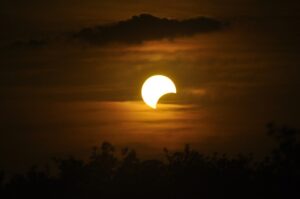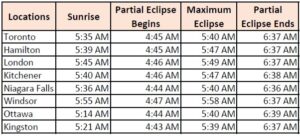Experience the “Ring of Fire”: Canada’s first solar eclipse of the year

If you are an early riser, you may be lucky enough to catch the first solar eclipse of 2021. Around sunrise on June 10, northern and eastern areas of North America, including Greenland, Europe and Asia will get the opportunity to experience the dramatic event. That is of course, providing mother nature cooperates and offers up a clear sky.
In Canada, the entire eclipse will be visible from start to finish for most people living north of a line that runs roughly from Halifax, Nova Scotia in the east up to Churchill, Manitoba. Those living in northern Ontario will have a “front-row seat”.
Weather permitting, Torontonians will be treated to a partial eclipse, a “crescent moon” so to speak. The moon will cover about 86% of the sun’s diameter.
In Toronto, the celestial event will begin shortly before sunrise, at 5:35am, reaching it’s peak at 5:40am and ending by 6:38am. (See chart below)
The solar eclipse, also known as the “Ring of Fire”, occurs when the Moon moves between the Sun and the Earth. The phenomenon blocks the Sun’s light and casts a shadow on Earth.
Solar eclipses are incredible to experience and marvelous to witness. However, it is advisable to follow the dire warnings to not risk severe damage to the eyes by looking directly at the sun. Regular sunglasses do not protect the eyes for this type of viewing. It is recommended to use proper eclipse glasses made specifically for sun viewing to prevent damage to the eyes.
If you do not have the necessary eye protection with appropriate filters, a homemade pinhole camera is the safest way to watch the event. Poke a small hole in an index card and with the sun against your back, hold the card extended in your arms. Point it towards the ground to view the projected image, or towards another card about 2-3 feet away.
The next total solar eclipse will appear on December 4, 2021.
Click here to watch the event live: Live Stream Solar Eclipse 2021




